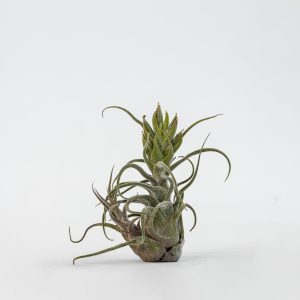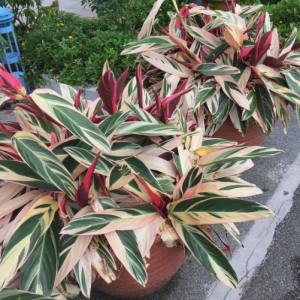Plant enthusiasts admire bromeliads as unusual and striking indoor plants because of their rich hues and distinctive forms. These plants not only provide a contemporary and tropical touch to the house surroundings but also help to improve the air quality.

Air Plant Mystery Box
Bromeliad traits
Among many indoor plants, bromeliads are particularly striking in their vibrant, brilliant look. Usually ribbon-like in shape, their leaves are lush and variegated in color. Common floral hues include pink, red, orange and yellow. Often lasting weeks, these blossoms are not only vibrant but also very long-lasting. Such qualities make bromeliads quite appropriate for modern and tropical homes.
Bright blooms
Bromeliads’ striking blossoms are among its most arresting characteristics. Whether brilliant pink or scorching red, these hues may liven the inside space. It stands out sharply visually against their ribbon-like green foliage. One of the main benefits of bromeliads is their longevity; particularly in cases where the blossoming season spans several weeks, this helps flower enthusiasts to savor their beauty for a lengthy duration.
Purification of the Air
Apart from their exquisite look, bromeliads offer great capacity for air filtration. Studies have shown that bromeliads may efficiently eliminate indoor air contaminants like formaldehyde. Common indoor pollutants include formaldehyde often found in paint, gas-burning appliances, and dry-cleaned clothes originate from Indoor bromeliads help to greatly enhance air quality and provide a better living space.
Cycle of Development and Destruction
Furthermore unusual in their development cycle are bromeliads. Usually, the mother plant slowly deteriorates after its major blossoms start to fade. Still, this does not spell the end of the plant’s existence. Bromeliads will produce young plants—new seedlings—around the base at this time. With correct planting and care, these young plants may develop into new plants, therefore sustaining the life of the bromeliad.
Growing and maintaining Bromeliaceae
Growing bromeliads requires little knowledge, and even for households without garden experience, these plants are quite low maintenance. Still, knowing the plant’s light requirements, watering schedule, and other fundamental care issues will help to guarantee its healthy development.
Lighting Requirements
Usually, medium to bright light is what bromeliads thrive on. While certain variances may thrive in full sunshine, most bromeliads are better suited for indirect light. It is advised to cover the leaves from too much sunlight using gauze curtains or transparent blinds if positioned next to a sunny window.
Climate and humidity
Generally speaking, bromeliads demand warm surroundings. Room temperatures between 18°C and 24°C are ideal for them; winter should not have them dip below 15°C. One more crucial element influencing the bromeliad development is indoor air humidity. While they may survive in a drier air environment, raising the air humidity suitably can help their leaves develop healthily.
Watering calls to attention
The idea of keeping the soil moist but not too damp should guide waterings of bromeliads. Although their water needs vary, most bromeliads are drought-tolerant and will thrive even if you sometimes forget to water them. To prevent overwatering-induced root rot, it is advised to therefore find out if the soil is dry before every watering.
Fertilisation and Soil
Bromeliads need not frequent fertilizing. Usually, once a month using diluted liquid fertilizer is enough to satisfy their growth requirements. Regarding choice of soil, bromeliads like a well-drained substrate. To increase drainage in regular potting soil, mix some coarse sand or perlite with a normal succulent soil sold on the market.
Outdoor Propaganda
The care will vary if you want to keep bromeliads outside. Bromeliads vary in heat and cold tolerance from variation to variety. While some bromeliads like to thrive in the shade, others can survive full light. Therefore, one should choose an outdoor planting site based on the requirements of the particular type.
Careers
Bromeliads are not fit for human or animal food, it should be underlined. If children or dogs live at home, take cautious to arrange these plants out of reach to prevent inadvertent consumption and poisoning. Apart from that, routinely examine the leaves and roots of the plants to stop pests and illnesses from arising. Once symptoms of pests and illnesses are discovered, actions should be done in time to handle them.
Bromeliad reproduction and transplanting
Usually, division is used for propagation of bromeliads. Most home gardeners will find this approach appropriate as it is straightforward and easy to use. The young bromeliad plants surrounding a declining mother plant may be split and moved into a fresh container.
Division expansion
For bromeliads, division is the most often used technique of propagation. Usually, a cluster of baby seedlings will develop at the foot of the mother plant as her big bloom starts to wither. These young plants fit well for independent planting in fresh pots.
Watering the plant initially is advised before division to help to ease the removal from the ground. Using a sharp knife, then, gently detach the baby plants from the mother plant so that every new plant has a whole root system. At last, place the young plants in a fresh pot and tend them using standard planting and care techniques.
Repotting and potting
Select a container with adequate drainage when planting bromeliads to reduce overwatering-caused root rot. Usually, bromeliads should be replaced every two years to provide additional growth area and stop the buildup of salt and contaminants in the ground from damaging the plants.
To guarantee enough nutrients, you may remove some of the old soil and mix some organic fertilizer into the new soil while repotting. To guarantee the plant has sufficient growth room, the new pot should be one size bigger than the previous one.

Bromeliad Christmas Bowls
Because of their simple care and air-purifying properties, Bromeliaceae not only draw many plant enthusiasts with their vivid colors and unusual forms but also become a perfect indoor plant option. Unquestionably, bromeliads have been valuable whether used as a natural air purifying method or as home décor accentuation. Understanding its growth traits, planting and care techniques will help you to easily include this lovely plant into your living area, thus giving a bit of tropical flare to your house setting and so benefiting your health.
Post time: 08-31-2024




